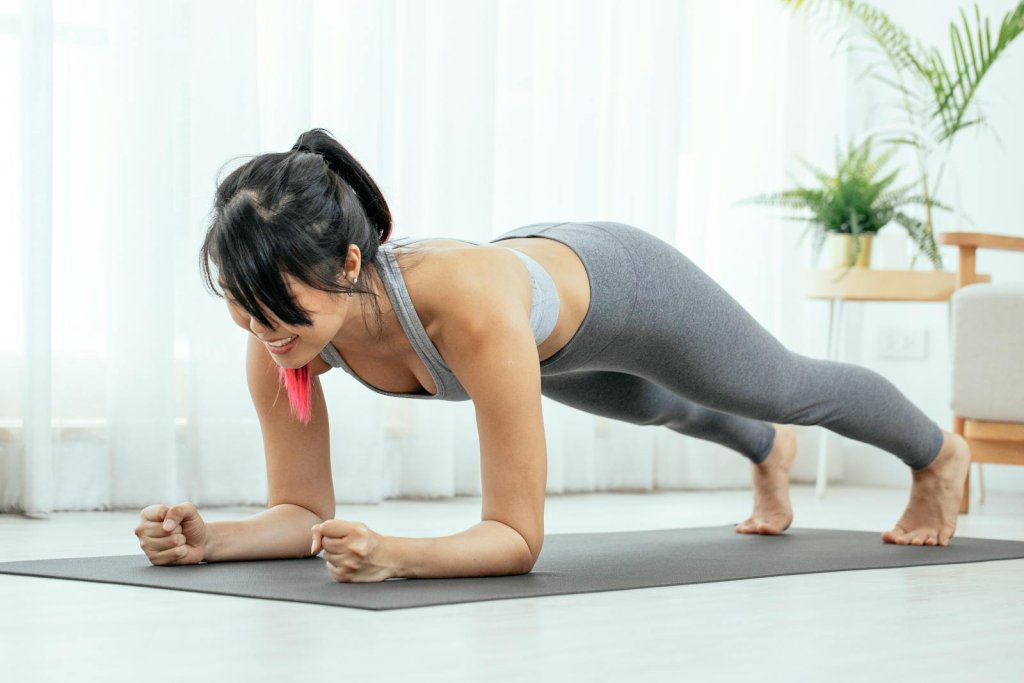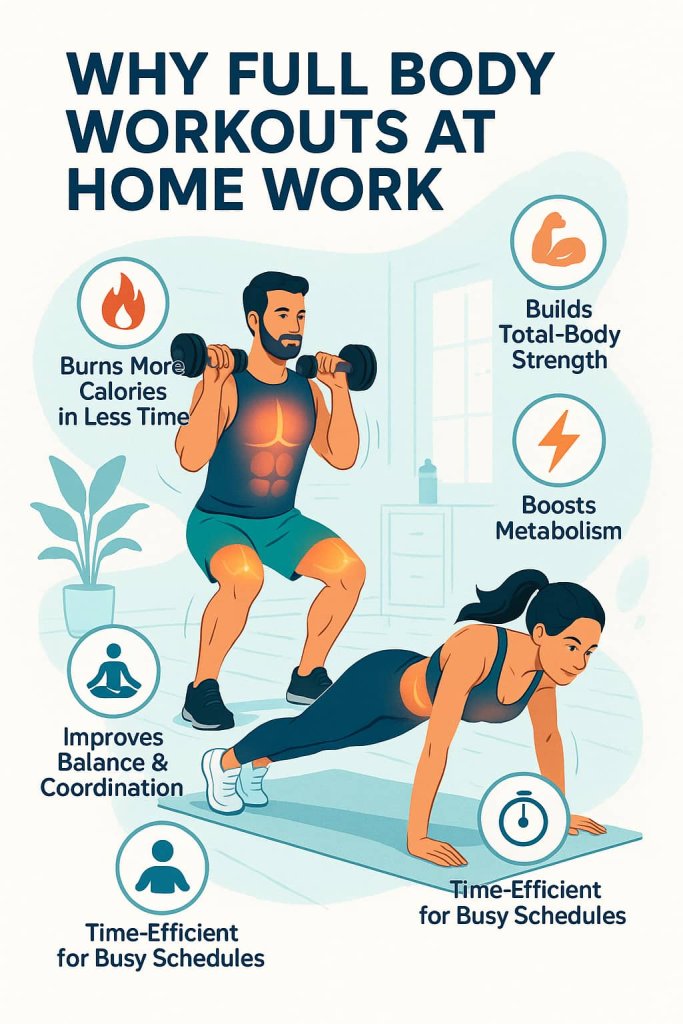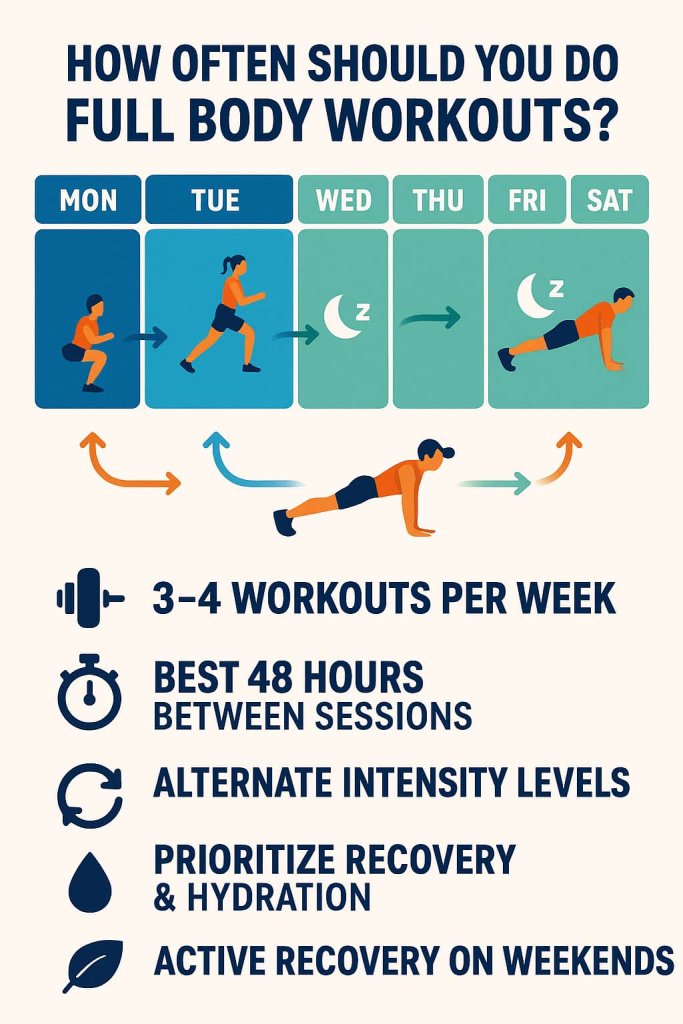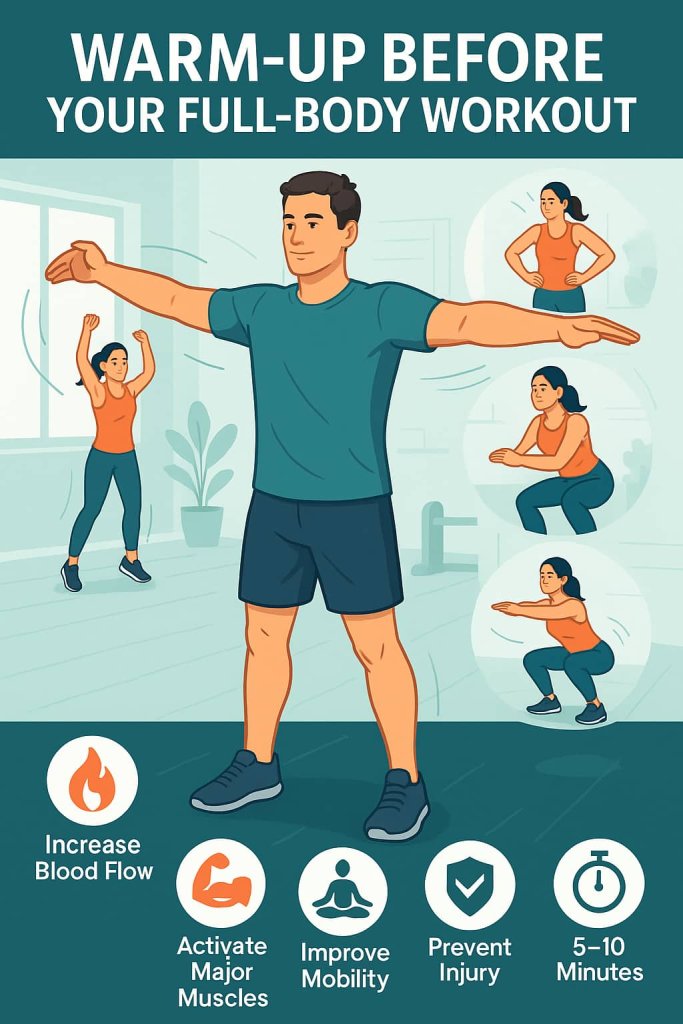Yes — you can build muscle and burn fat effectively with full body workouts at home. These routines target every major muscle group in a single session, helping you get strong, lean, and fit without needing a gym membership.

Full body workouts are especially effective because they combine strength and cardio benefits — boosting metabolism, improving endurance, and promoting total-body balance. Whether you have dumbbells, resistance bands, or just your body weight, this guide covers the best home exercises to maximize results safely and efficiently.
Why Full Body Workouts at Home Work
According to ACE, full-body training recruits multiple muscle groups at once — increasing calorie expenditure and triggering more growth hormones than isolated exercises. This makes it ideal for both fat loss and muscle building.

Research published in the Journal of Strength and Conditioning Research (2024) found that full-body training 3 times per week produced similar strength and hypertrophy gains to split routines, with less total training time.
Key Benefits
- Burns more calories in less time
- Improves muscle balance and coordination
- Boosts metabolism for faster fat loss
- Builds strength and endurance simultaneously
- Perfect for beginners or busy individuals
How Often Should You Do Full Body Workouts

Train 3–4 times per week, allowing at least one rest day between sessions.
Alternate intensity levels (light, moderate, intense) to support recovery and muscle growth.
Example weekly plan:
- Day 1: Full Body Strength
- Day 2: Rest or Light Cardio
- Day 3: Full Body HIIT
- Day 4: Rest
- Day 5: Core & Conditioning
- Weekend: Active recovery or stretching
Warm-Up Before You Begin
Before any workout, take 5–10 minutes to warm up.

Try:
- Arm circles
- Jumping jacks
- Bodyweight squats
- Hip rotations
- High knees
A proper warm-up boosts circulation, prepares joints, and reduces injury risk.
15 Best Full Body Workouts at Home
Each workout below combines compound and functional movements — designed to hit your chest, back, legs, shoulders, and core for total-body transformation.
1. Bodyweight Squat
Why it works: Strengthens the quadriceps, glutes, and hamstrings while improving lower-body mobility and stability. It mimics everyday movements like sitting and standing, making it an essential foundational exercise.
Muscles worked: Quads, glutes, hamstrings, and core.
How to do it:
- Stand tall with feet shoulder-width apart.
- Keep your chest lifted and core tight.
- Push hips back as if sitting into a chair, lowering until thighs are parallel to the floor.
- Press through heels to stand tall again. Perform 15–20 reps.
Trainer Tip: Keep knees aligned with toes and avoid letting them cave inward for proper joint protection.
2. Push-Ups
Why it works: This compound movement builds upper-body strength, endurance, and core stability — all without equipment.
Muscles worked: Chest, shoulders, triceps, and core.
How to do it:
- Begin in a high plank with hands slightly wider than shoulders.
- Keep body straight from head to heels.
- Lower chest toward the floor, elbows at about 45° from your sides.
- Push back up to starting position. Perform 10–15 reps.
Trainer Tip: If full push-ups are too challenging, perform them on knees or against a wall to maintain form.
3. Jump Squats
Why it works: This explosive move develops power, coordination, and cardiovascular fitness while toning the legs and glutes.
Muscles worked: Quads, glutes, calves, and core.
How to do it:
- Start with feet shoulder-width apart.
- Lower into a squat, then drive upward explosively.
- Land softly with knees slightly bent and descend immediately into the next rep.
Perform 12–15 controlled reps.
Trainer Tip: Focus on soft, quiet landings — this protects your joints and enhances muscle control.
4. Plank to Push-Up
Why it works: Blends core stability and upper-body strength, activating multiple muscle groups while improving shoulder endurance.
Muscles worked: Core, shoulders, triceps, and chest.
How to do it:
- Start in a forearm plank position.
- Press up onto one hand, then the other into a high plank.
- Lower back down to forearms, alternating leading arms each rep. Perform 10–12 reps.
Trainer Tip: Keep hips square and avoid rocking side to side — the goal is stability, not speed.
5. Reverse Lunges
Why it works: Builds unilateral leg strength and balance while being gentler on knees than forward lunges.
Muscles worked: Glutes, quads, hamstrings, and core.
How to do it:
- Stand tall with feet hip-width apart.
- Step one leg backward into a lunge, keeping front knee over ankle.
- Push through front heel to return to standing. Alternate legs for 12–15 reps per side.
Trainer Tip: Keep your torso upright throughout — leaning forward reduces glute engagement.
6. Mountain Climbers
Why it works: A dynamic, high-intensity movement that strengthens the core while elevating heart rate for fat loss.
Muscles worked: Core, shoulders, arms, and legs.
How to do it:
- Begin in a plank position.
- Drive one knee toward your chest, then switch quickly.
- Continue alternating legs in a running motion for 30–40 seconds.
Trainer Tip: Keep hips low and shoulders stacked over wrists — this ensures your core does the work, not your lower back.
7. Glute Bridge
Why it works: Strengthens the posterior chain, improves hip stability, and reduces lower-back strain.
Muscles worked: Glutes, hamstrings, and lower back.
How to do it:
- Lie flat on your back with knees bent and feet hip-width apart.
- Press through heels to lift hips until your body forms a straight line from knees to shoulders.
- Squeeze glutes at the top and lower slowly. Perform 15 reps.
Trainer Tip: Keep core tight and avoid arching your back — focus on contracting your glutes, not your spine.
8. Dumbbell Deadlift (optional equipment)
Why it works: Builds total posterior chain strength and enhances posture by targeting key stabilizing muscles.
Muscles worked: Hamstrings, glutes, lower back, and forearms.
How to do it:
- Hold a pair of dumbbells in front of your thighs.
- With soft knees, hinge at the hips and lower weights toward mid-shin.
- Keep back straight and core braced, then return to standing by squeezing your glutes. Perform 12 reps.
Trainer Tip: Avoid rounding your spine — hinge from your hips and keep your gaze forward.
9. Burpees
Why it works: Combines cardio, strength, and coordination — one of the best full-body calorie burners.
Muscles worked: Chest, arms, legs, glutes, and core.
How to do it:
- From standing, squat down and place hands on the floor.
- Jump feet back into a plank, perform a push-up, jump feet forward, then leap explosively upward.
- Land softly and repeat for 10–12 reps.
Trainer Tip: Move rhythmically and focus on quality reps instead of speed for safety and endurance.
10. Superman Hold
Why it works: Strengthens spinal extensors and improves posture, which supports a healthy back.
Muscles worked: Lower back, glutes, shoulders.
How to do it:
- Lie face down with arms extended forward.
- Simultaneously lift arms, chest, and legs off the ground.
- Hold for 3–5 seconds, lower gently, and repeat for 12–15 reps.
Trainer Tip: Keep your neck neutral and squeeze glutes at the top — avoid overextending your back.
11. Triceps Dips (using chair)
Why it works: Isolates and tones the triceps while engaging shoulders and chest for arm definition.
Muscles worked: Triceps, chest, shoulders, and core.
How to do it:
- Sit on the edge of a sturdy chair, hands beside hips.
- Walk feet forward, then lower body by bending elbows to 90°.
- Push through palms to rise back up. Perform 12–15 reps.
Trainer Tip: Keep elbows pointing straight back — flaring them out increases shoulder strain.
12. Standing Side Crunch
Why it works: Enhances oblique strength, balance, and functional core stability without floor exercises.
Muscles worked: Obliques, abs, and hip flexors.
How to do it:
- Stand tall with hands behind head.
- Bring right elbow toward right knee as you lift leg to the side.
- Return to start and alternate for 20 total reps.
Trainer Tip: Engage your core with each lift — control the motion to truly activate the obliques.
13. Wall Sit
Why it works: Develops muscular endurance in the quads and glutes while improving lower-body stability.
Muscles worked: Quads, hamstrings, glutes.
How to do it:
- Stand with your back against a wall, feet shoulder-width apart.
- Slide down until knees are bent at 90°, thighs parallel to floor.
- Hold for 30–60 seconds while keeping back flat.
Trainer Tip: Press your heels into the floor and focus on steady breathing to hold longer.
14. Jumping Lunges
Why it works: Increases lower-body power, agility, and cardiovascular endurance.
Muscles worked: Quads, glutes, calves, and core.
How to do it:
- Begin in a lunge position.
- Jump explosively, switching legs midair, and land softly into the next lunge.
- Continue alternating for 10–12 reps per leg.
Trainer Tip: Keep chest up and core tight — prioritize balance before speed to protect your knees.
15. High Plank Shoulder Taps
Why it works: Strengthens the core while improving shoulder stability and coordination.
Muscles worked: Core, triceps, shoulders, and chest.
How to do it:
- Begin in a high plank position.
- Tap right shoulder with left hand, then left shoulder with right hand.
- Keep hips steady and body aligned. Perform 20 total taps.
Trainer Tip: Move slowly and minimize hip sway — control is key for deep core engagement.
Cool Down and Recovery
End each session with light stretching:
- Hamstring and quad stretches
- Shoulder rolls
- Cat-cow spine mobility
- Deep breathing for relaxation
Proper recovery supports muscle repair and prevents soreness.
Pro Tips for Faster Results
- Stay consistent: Train at least 3x per week.
- Progress gradually: Add reps, sets, or resistance over time.
- Track performance: Use a notebook or app to log progress.
- Prioritize nutrition: Eat protein-rich foods for muscle recovery.
- Sleep 7–9 hours: Growth happens during rest.
Common Mistakes to Avoid
- Skipping warm-up or cool down
- Using poor form for speed
- Overtraining without rest
- Ignoring nutrition and hydration
- Not tracking progress
FAQs
1. Can I build muscle at home without weights?
Yes, by focusing on bodyweight compound exercises and progressive overload (more reps, slower tempo, or added resistance bands).
2. How long should a full-body home workout last?
Aim for 30–45 minutes, including warm-up and cool-down.
3. Do I need to work out every day?
No — 3–4 weekly sessions are sufficient for most people.
4. What if I’m a beginner?
Start with simpler moves (bodyweight squats, knee push-ups, glute bridges) and increase intensity gradually.
5. Can full-body workouts replace the gym?
Yes, if you’re consistent. You can achieve excellent strength and conditioning using only home workouts.
6. Is this suitable for weight loss?
Absolutely — combining strength and cardio burns fat effectively.
7. What equipment is ideal for home training?
Dumbbells, resistance bands, and a yoga mat are great starters.
Conclusion
Full body workouts at home are a powerful, time-efficient way to build muscle, burn fat, and stay consistent — no gym required. With dedication, proper form, and progressive overload, you can transform your physique and fitness level anywhere.
Start today — your body is your best gym.
References
- Ramos-Campo DJ, et al. (2024). Efficacy of Split Versus Full-Body Resistance Training on Strength and Muscle Growth — Systematic Review & Meta-analysis (JSCR).
Lippincott Journals - Carneiro MAS, et al. (2024). Full-body resistance training promotes greater fat-mass loss than a split routine (Randomized Trial).
Wiley Online Library - American College of Sports Medicine (2024). Physical Activity Guidelines — strength training ≥2 days/week.
ACSM - Hermann T, et al. (2025). Muscular adaptations with single-set resistance training — time-efficient strategies (MSSE).
PubMed - ACE (E. Bach). A Detailed Guide to Designing Activity-Specific Warm-Up & Mobility Drills.
ACE Fitness - Li FY, et al. (2023). Systematic Review & Network Meta-analysis: Dynamic vs. Static Warm-Ups for Explosive Performance.
BioMed Central - Oliva-Lozano JM, et al. (2020). Core Muscle Activity During Physical Fitness Exercises — EMG Systematic Review (planks, crunches, instability).
PMC
